
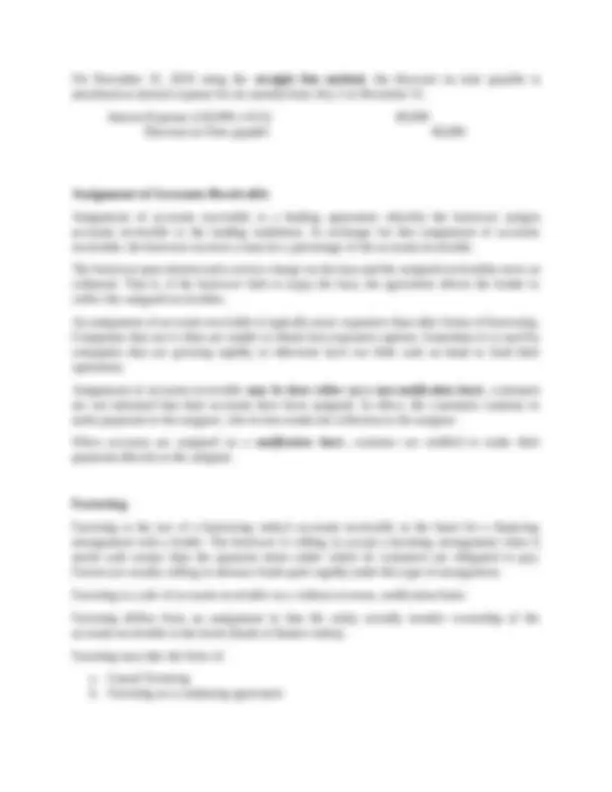
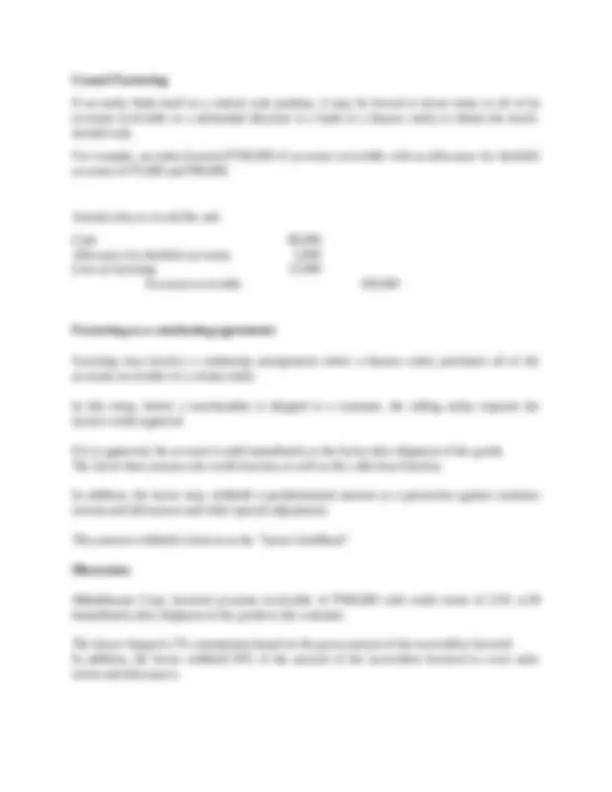
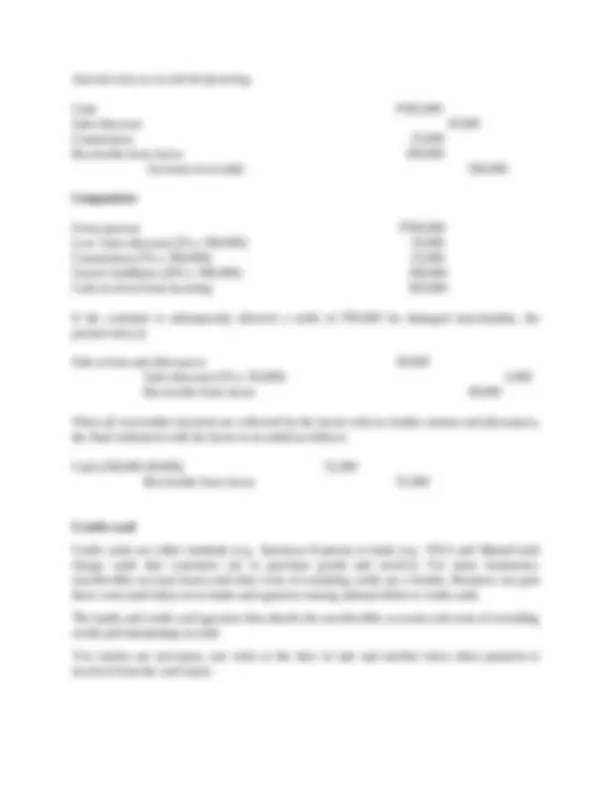
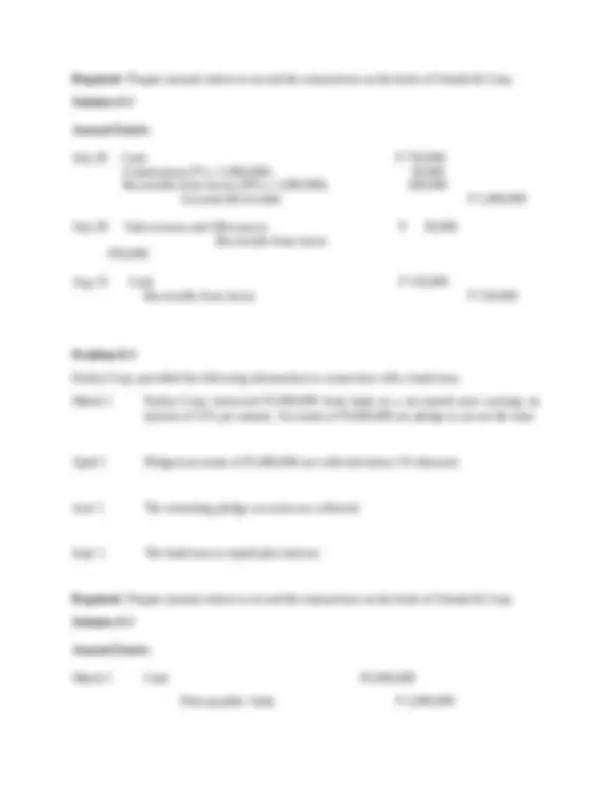
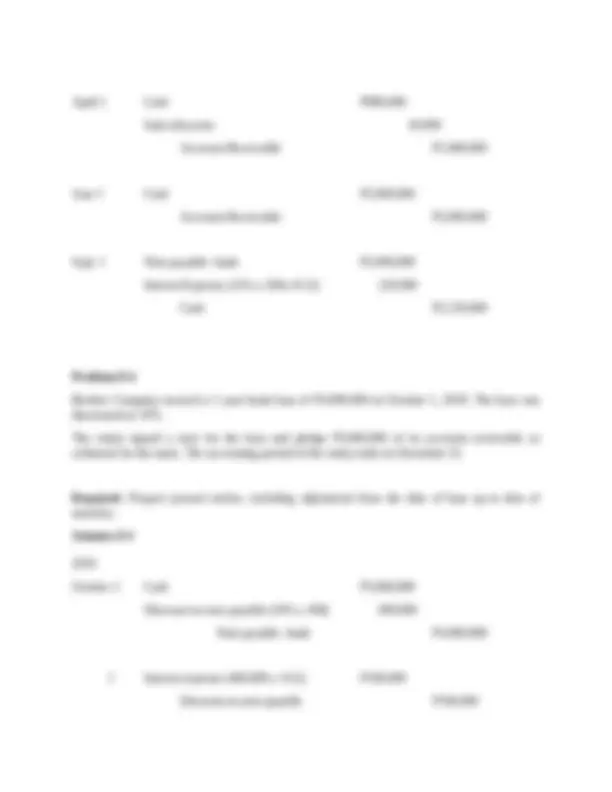
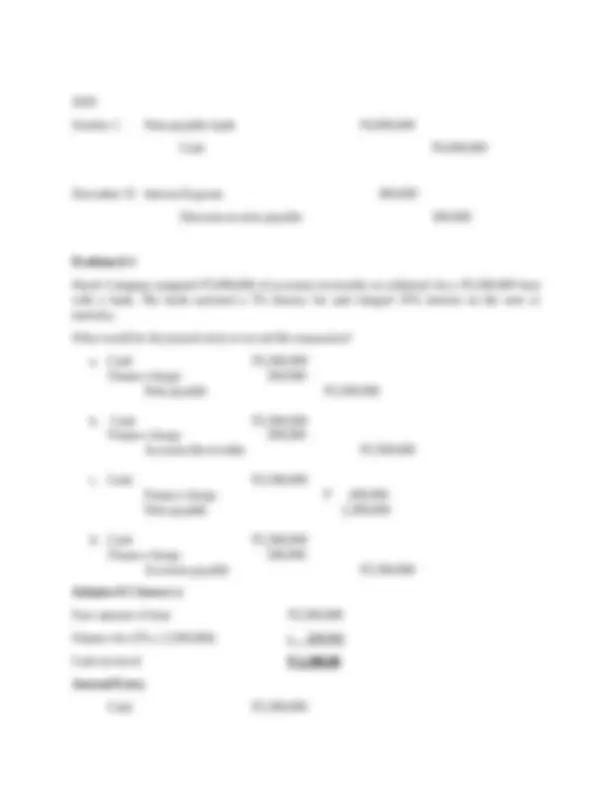
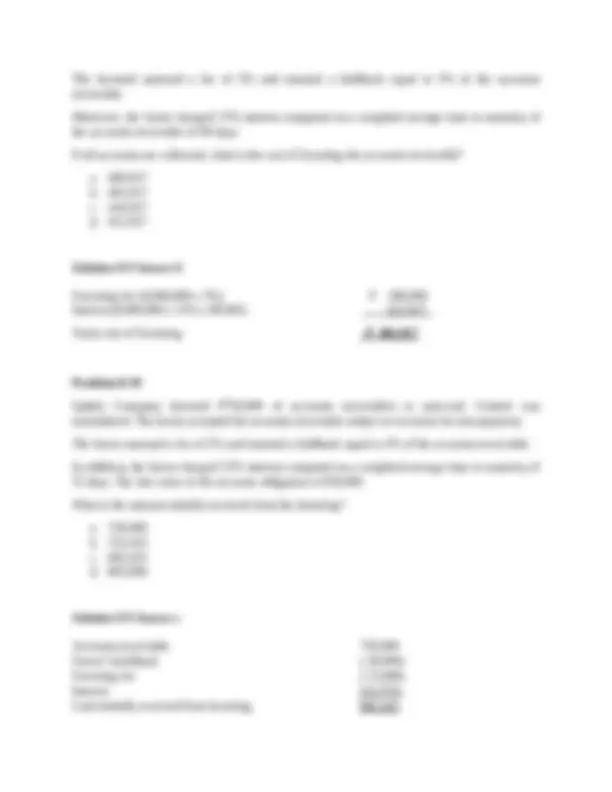
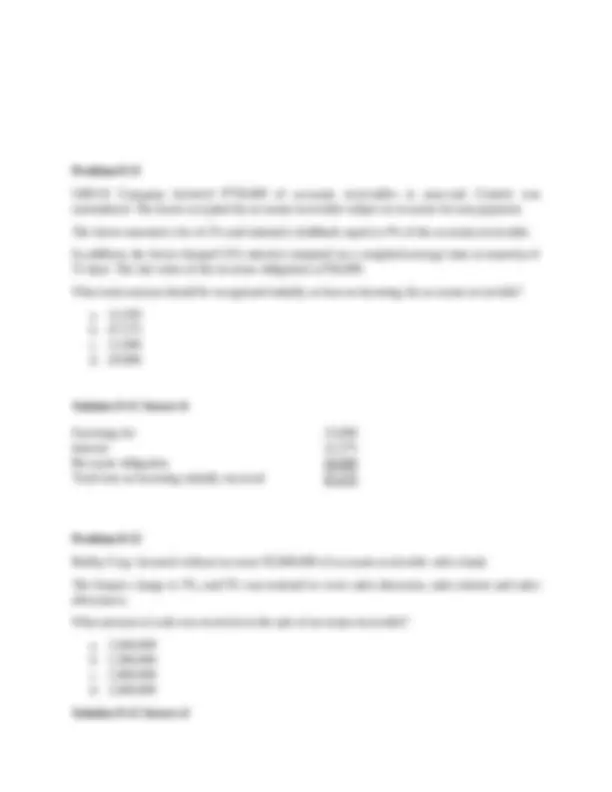
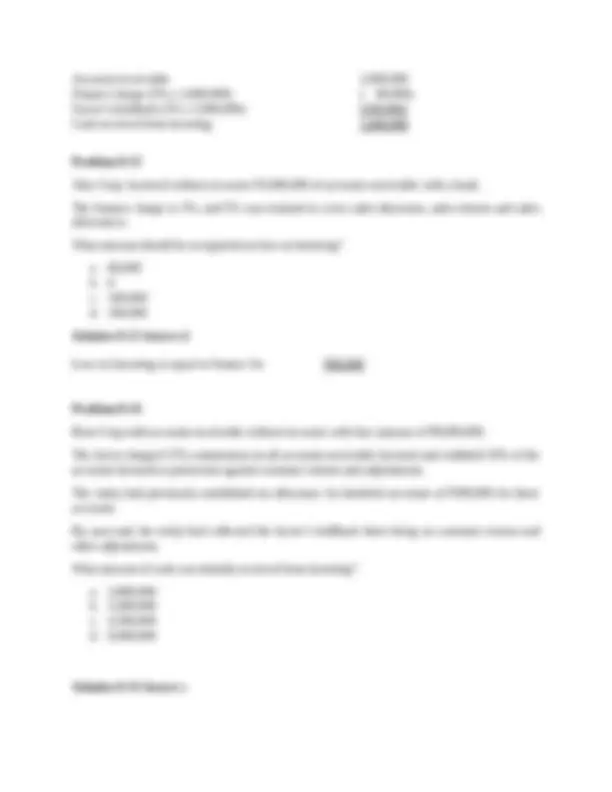
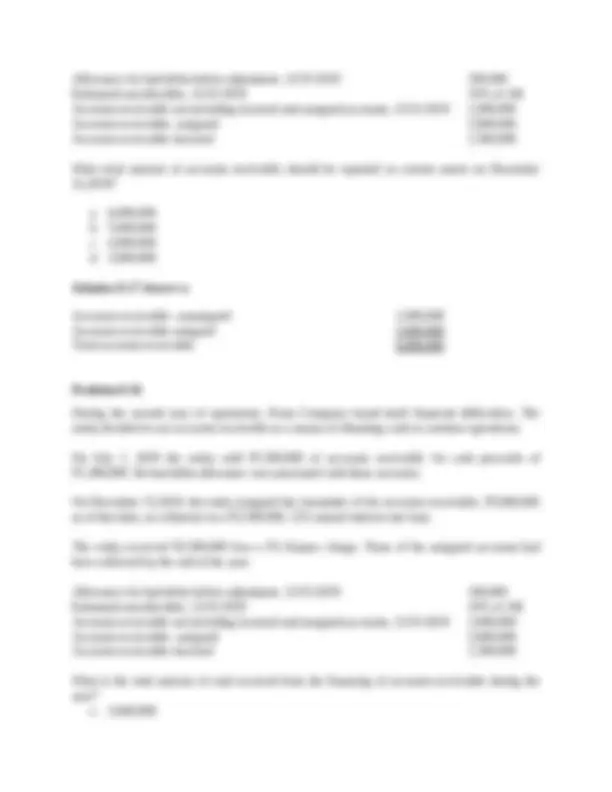
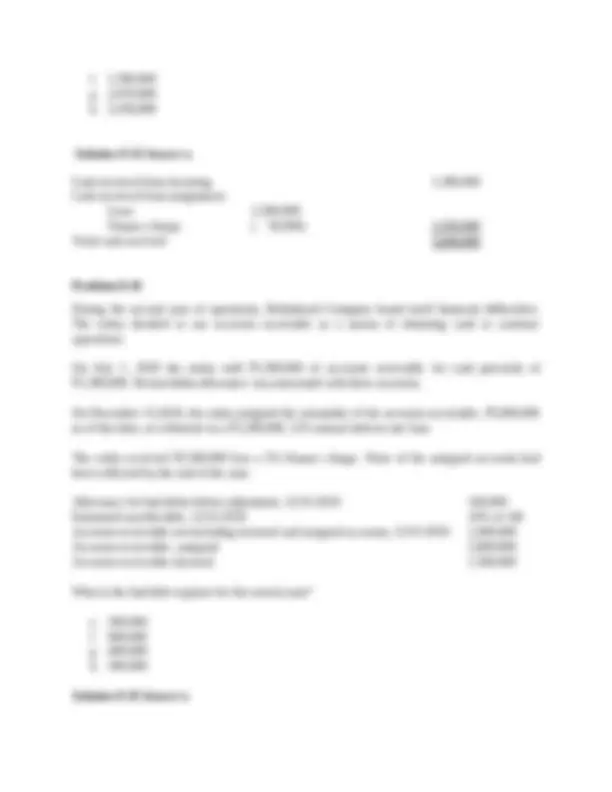
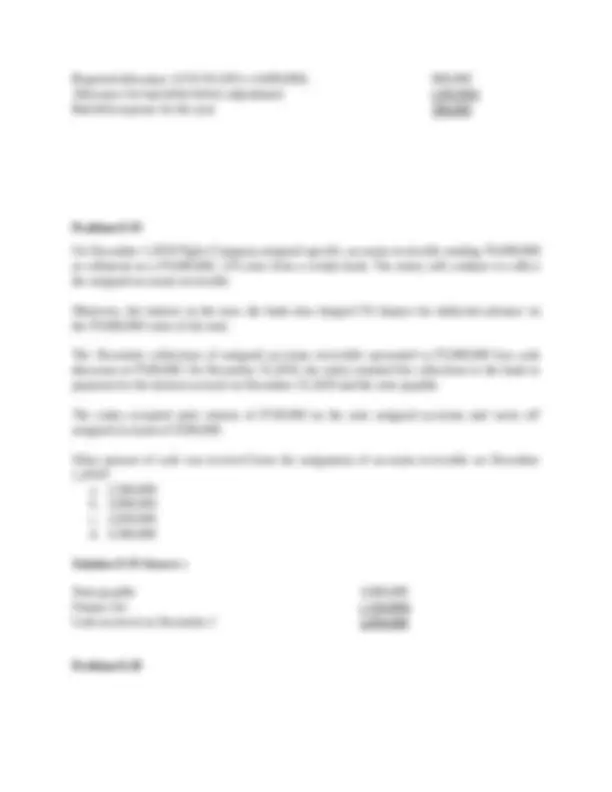
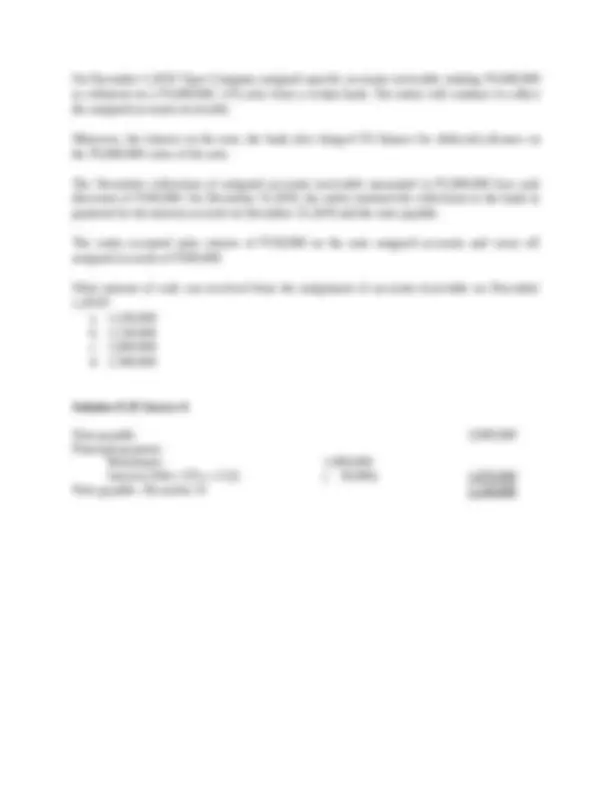


Study with the several resources on Docsity

Earn points by helping other students or get them with a premium plan


Prepare for your exams
Study with the several resources on Docsity

Earn points to download
Earn points by helping other students or get them with a premium plan
Community
Ask the community for help and clear up your study doubts
Discover the best universities in your country according to Docsity users
Free resources
Download our free guides on studying techniques, anxiety management strategies, and thesis advice from Docsity tutors
The concept of receivable financing and its common forms, including pledge, assignment, and factoring. It describes how accounts receivable financing works and how it can be structured as either an asset sale or a loan. The document also provides examples of journal entries and calculations related to receivable financing. Additionally, it discusses credit cards as a form of financing and how businesses can pass on the costs and risks of extending credit to banks and credit card agencies.
Typology: Lecture notes
1 / 21

This page cannot be seen from the preview
Don't miss anything!














Accounts receivable financing, also called factoring, is a method of selling receivables in order to obtain cash for company operations. Accounts receivable (A/R) are amounts owed by customers for goods and services a company has sold to those customers. Accounts receivable (AR) financing is a type of financing arrangement in which a company receives financing capital related to a portion of its accounts receivable. Accounts receivable financing agreements can be structured in multiple ways usually with the basis as either an asset sale or a loan.
The common forms of receivable financing are: a. Pledge of accounts receivable b. Assignment of accounts receivable c. Factoring of accounts receivable d. Discounting of notes receivable
Accounts receivable pledging occurs when a business uses its accounts receivable asset as collateral on a loan, usually a line of credit. When accounts receivable are used as collateral on a loan, the lender typically limits the amount of the loan to either: 70% to 80% of the total amount of accounts receivable outstanding; or A percentage of the accounts receivable that declines based on the age of the receivables. The latter alternative is safer from the perspective of the lender (and is therefore more commonly used), since it allows for more specific identification of those receivables least likely to be collected. For example, a bank may not allow any accounts receivable to be used as collateral if they are more than 90 days old, 80% of all receivables between 30 and 90 days old, and 95% of all receivables that are 30 days old or less. The lender may also specifically exclude any receivables for which the company has granted unusually long payment terms. By being this conservative in calculating the maximum amount to be loaned, the lender protects itself from issuing debt that cannot be fully offset by collateral in the event of a payment default.
On July 1, 2019, UNION Company borrowed P1,000,000 from Banco De Oro and issued a promissory note for the same. The term of the loan is one year and discounted at 12%. The entity pledge accounts receivable of P2,000,000 to secure the loan. On July 10, the journal entry to record the loan is: Cash 880, Discount on Note payable 120, Note payable- bank 1,000, If the loan is discounted , in the banking perspective this means that the interest for the term of the loan is deducted in advance. Face value of loan 1,000, Interest deducted in advance (1M/12%) ( 120,000) Net proceeds 880,
If an entity finds itself in a critical cash position, it may be forced to factor some or all of its accounts receivable at a substantial discount to a bank or a finance entity to obtain the much- needed cash. For example, an entity factored P100,000 of accounts receivable with an allowance for doubtful accounts of P5,000 and P80,000. Journal entry to record the sale Cash 80, Allowance for doubtful accounts 5, Loss on factoring 15, Accounts receivable 100,
Factoring may involve a continuing arrangement where a finance entity purchases all of the accounts receivable of a certain entity. In this setup, before a merchandise is shipped to a customer, the selling entity requests the factor's credit approval. If it is approved, the account is sold immediately to the factor after shipment of the goods. The factor then assumes the credit function as well as the collection function. In addition, the factor may withhold a predetermined amount as a protection against customer returns and allowances and other special adjustments. This amount withheld is known as the "factor's holdback". Illustration Mahabharata Corp. factored accounts receivable of P500,000 with credit terms of 2/10, n/ immediately after shipment of the goods to the customer. The factor charged a 5% commission based on the gross amount of the receivables factored. In addition, the factor withheld 20% of the amount of the receivables factored to cover sales return and allowances.
Journal entry to record the factoring: Cash P365, Sales discount 10, Commission 25, Receivable from factor 100, Accounts receivable 500, Computation Gross amount P500, Less: Sales discount (2% x 500,000) 10, Commission (5% x 500,000) 25, Factor's holdback (20% x 500,000) 100, Cash received from factoring 365, If the customer is subsequently allowed a credit of P50,000 for damaged merchandise, the journal entry is: Sales return and allowances 50, Sales discount (2% x 50,000) 1, Receivable from factor 49, When all receivables factored are collected by the factor with no further returns and allowances, the final settlement with the factor is recorded as follows: Cash (100,000-49,000) 51, Receivable from factor 51,
Credit cards are either nonbank (e.g. American Express) or bank (e.g. VISA and MasterCard) charge cards that customers use to purchase goods and services. For some businesses, uncollectible account losses and other costs of extending credit are a burden. Business can pass these costs (and risks) on to banks and agencies issuing national debit or credit cards. The banks and credit card agencies then absorb the uncollectible accounts and costs of extending credit and maintaining records Two entries are necessary, one entry at the time of sale and another entry when payment is received from the card issuer.
Problem 8- On March 1, 2019, Apple Company borrowed P50,000 from a bank and signed a 12% one month note payable. The bank charged 1% initial fee. Apple Company assigned P73,000 of its accounts receivable to the bank as a security. During March 2019, the company collected P70,000 of the assigned accounts receivable and paid the principle and interest on note payable to the bank on April 1. P3,000 of the sales were returned by the customers. Required: Prepare the necessary journal entries by Apple Company. Solution 8- Journal Entries on March 1: a. Cash P49, Finance Charge 500 Notes Payable P50, b. Accounts Receivable Assigned P73, Accounts Receivable 73, Journal Entries on April 1: a. Cash P70, Sales Returns 3, Accounts Receivable Assigned P73, b. Notes Payable P50, Interest Expense 500 Cash P50, Problem 8- A factor has agreed to purchase selected accounts receivable from Friends & Corp. The factor charged 5% commission and 20% holdback. The following accounts are sold on July 26: Invoice Date Customer Amount July 23 A 300, July 25 B 500, July 24 C 200, On July 28, customer B was granted a credit of P50,000 for returned merchandise. Final settlement is made with the factor on August 31.
Required: Prepare journal entries to record the transactions on the book of Friends & Corp. Solution 8- Journal Entries July 26 Cash P 750, Commission (5% x 1,000,000) 50, Receivable from factor (20% x 1,000,000) 200, Accounts Receivable P 1,000, July 28 Sales returns and Allowances P 50, Receivable from factor P50, Aug 31 Cash P 150, Receivable from factor P 150, Problem 8- Pachty Corp. provided the following information in connection with a bank loan. March 1 Pachty Corp. borrowed P2,000,000 from bank on a six-month note carrying an interest of 12% per annum. Accounts of P3,000,000 are pledge to secure the loan. April 1 Pledged accounts of P1,000,000 are collected minus 2% discount. June 1 The remaining pledge accounts are collected. Sept. 1 The bank loan is repaid plus interest. Required: Prepare journal entries to record the transactions on the book of Friends & Corp. Solution 8- Journal Entries March 1 Cash P2,000, Note payable- bank P 2,000,
October 1 Note payable-bank P4,000, Cash P4,000, December 31 Interest Expense 300, Discount on note payable 300, Problem 8- Hawk Company assigned P5,000,000 of accounts receivable as collateral for a P2,500,000 loan with a bank. The bank assessed a 5% finance fee and charged 10% interest on the note at maturity. What would be the journal entry to record the transaction? a. Cash P2,300, Finance charge 200, Note payable P2,500, b. Cash P2,300, Finance charge 200, Accounts Receivable P2,500, c. Cash P2,500, Finance charge P 200, Note payable 2,300, d. Cash P2,300, Finance charge 200, Accounts payable P2,500, Solution 8-5 Answer a Face amount of loan P2,500, Finance fee (5% x 2,500,000) ( 200,00) Cash received P 2,300, Journal Entry Cash P2,300,
Finance charge 200, Note payable P2,500, Note: No gain or loss is recognized on the transfer of accounts receivable because assignment of accounts receivable is a secured borrowing and not a sale. Problem 8- Ben Company sold accounts receivable without recourse for P5,300,000. The entity received P5,000,000 cash immediately from the factor. The remaining P300,000 will be received once the factor verifies that none of the accounts receivable is in dispute. The accounts receivable had a face amount of P6,000,000. The entity had previously established an allowance for bad debts of P250,000 in connection with such accounts. What amount of loss on factoring should be recognized? a. 900, b. 420, c. 450, d. 380, Solution 8-6 Answer a Sales price P5, 300, Carrying amount of accounts receivable 5, 750, (6,000,000-250,000) Loss on factoring (P450,000) Problem 8- Care bare Company sold P5,800,000 in accounts receivable for cash of P5,000,000. The factor withheld 10% of the cash proceeds to allow for possible customer returns and adjustments. An allowance for doubtful accounts of P600,000 had previously been established by the entity in relation to these accounts. What amount of loss on factoring should be recognized? a. 400, b. 470, c. 270, d. 200,
The factored assessed a fee of 3% and retained a holdback equal to 5% of the accounts receivable. Moreover, the factor charged 15% interest computed on a weighted average time to maturity of the accounts receivable of 90 days. If all accounts are collected, what is the cost of factoring the accounts receivable? a. 400, b. 401, c. 410, d. 411, Solution 8-9 Answer b Factoring fee (6,000,000 x 3%) P 180, Interest (6,000,000 x 15% x 90/365) 221, Total cost of Factoring P 401, Problem 8- Spidey Company factored P750,000 of accounts receivables at year-end. Control was surrendered. The factor accepted the accounts receivable subject to recourse for non-payment. The factor assessed a fee of 2% and retained a holdback equal to 4% of the accounts receivable. In addition, the factor charged 12% interest computed on a weighted-average time to maturity of 51 days. The fair value of the recourse obligation is P20,000. What is the amount initially received from the factoring? a. 720, b. 722, c. 692, d. 805, Solution 8-9 Answer c Accounts receivable 750, Factor’s holdback ( 30,000) Factoring fee ( 15,000) Interest (12,575) Cash initially received from factoring 692,
Problem 8- GRO-X Company factored P750,000 of accounts receivables at year-end. Control was surrendered. The factor accepted the accounts receivable subject to recourse for non-payment. The factor assessed a fee of 2% and retained a holdback equal to 4% of the accounts receivable. In addition, the factor charged 12% interest computed on a weighted-average time to maturity of 51 days. The fair value of the recourse obligation is P20,000. What total amount should be recognized initially as loss on factoring the accounts receivable? a. 12, b. 47, c. 11, d. 20, Solution 8-11 Answer b Factoring fee 15, Interest 12, Recourse obligation 20, Total loss on factoring initially received 47, Problem 8- Bobby Corp. factored without recourse P2,000,000 of accounts receivable with a bank. The finance charge is 3%, and 5% was retained to cover sales discounts, sales returns and sales allowances. What amount of cash was received on the sale of accounts receivable? a. 1,940, b. 1,560, c. 1,900, d. 1,840, Solution 8-12 Answer d
Accounts receivable 6,000, Factor’s holdback (600,000) Commission (900,000) Cash received 4,500, Problem 8- Sampaguita Company sold accounts receivable without recourse with face amount of P6,000,000. The factor charged 15% commission on all accounts receivable factored and withheld 10% of the accounts factored as protection against customer returns and adjustments. The entity had previously established an allowance for doubtful accounts of P200,000 for these accounts. By year-end, the entity had collected the factor’s holdback there being no customer returns and other adjustments. What is the loss on factoring? a. 0 b. 900, c. 700, d. 400, Solution 8-15 Answer c Accounts receivable 6,000, Commission (900,000) Net sale price 5,100, Carrying amount of AR 5,800, Loss on factoring (700,000) Problem 8- During the second year of operations, Fiona Company found itself financial difficulties. The entity decided to use accounts receivable as a means of obtaining cash to continue operations. On July 1, 2019 the entity sold P1,500,000 of accounts receivable for cash proceeds of P1,390,000. No bad debts allowance was associated with these accounts.
On December 15,2019, the entity assigned the remainder of the accounts receivable, P5,000, as of that date, as collateral on a P2,500,000, 12% annual interest rate loan. The entity received P2,500,000 less a 2% finance charge. None of the assigned accounts had been collected by the end of the year. Allowance for bad debts before adjustment, 12/31/2019 100, Estimated uncollectible, 12/31/2019 10% of AR Accounts receivable not including factored and assigned accounts, 12/31/2019 1,000, Accounts receivable- assigned 5,000, Accounts receivable-factored 1,500, What is the total amount of cash received from the financing of accounts receivable during the year? a. 3,840, b. 1,590, c. 2,670, d. 2,456, Solution 8-16 Answer a Cash received from factoring 1,390, Cash received from assignment: Loan 2,500, Finance charge ( 50,000) 2,450, Total cash received 3,840, Problem 8- During the second year of operations, Winnie the Pooh Company found itself financial difficulties. The entity decided to use accounts receivable as a means of obtaining cash to continue operations. On July 1, 2019 the entity sold P1,500,000 of accounts receivable for cash proceeds of P1,390,000. No bad debts allowance was associated with these accounts. On December 15,2019, the entity assigned the remainder of the accounts receivable, P5,000, as of that date, as collateral on a P2,500,000, 12% annual interest rate loan. The entity received P2,500,000 less a 2% finance charge. None of the assigned accounts had been collected by the end of the year.
f. 1,590, g. 2,670, h. 2,456, Solution 8-16 Answer a Cash received from factoring 1,390, Cash received from assignment: Loan 2,500, Finance charge ( 50,000) 2,450, Total cash received 3,840, Problem 8- During the second year of operations, Robinhood Company found itself financial difficulties. The entity decided to use accounts receivable as a means of obtaining cash to continue operations. On July 1, 2019 the entity sold P1,500,000 of accounts receivable for cash proceeds of P1,390,000. No bad debts allowance was associated with these accounts. On December 15,2019, the entity assigned the remainder of the accounts receivable, P5,000, as of that date, as collateral on a P2,500,000, 12% annual interest rate loan. The entity received P2,500,000 less a 2% finance charge. None of the assigned accounts had been collected by the end of the year. Allowance for bad debts before adjustment, 12/31/2019 100, Estimated uncollectible, 12/31/2019 10% of AR Accounts receivable not including factored and assigned accounts, 12/31/2019 1,000, Accounts receivable- assigned 5,000, Accounts receivable-factored 1,500, What is the bad debt expense for the current year? e. 500, f. 600, g. 400, h. 300, Solution 8-18 Answer a
Required allowance-12/31/19 (10% x 6,000,000) 600, Allowance for bad debts before adjustments (100,000) Bad debt expense for the year 500, Problem 8- On December 1,2019 Piglet Company assigned specific accounts receivable totaling P4,000, as collateral on a P3,000,000, 12% note from a certain bank. The entity will continue to collect the assigned accounts receivable. Moreover, the interest on the note, the bank also charged 5% finance fee deducted advance on the P3,000,000 value of the note. The December collections of assigned accounts receivable amounted to P2,000,000 less cash discounts of P100,000. On December 31,2019, the entity remitted the collections to the bank in payment for the interest accrued on December 31,2019 and the note payable. The entity accepted sales returns of P150,000 on the note assigned accounts and wrote off assigned accounts of P200,000. What amount of cash was received from the assignment of accounts receivable on December 1,2019? a. 2,560, b. 3,000, c. 2,850, d. 4,560, Solution 8-19 Answer c Note payable 3,000, Finance fee ( 150,000) Cash received on December 1 2,850, Problem 8-